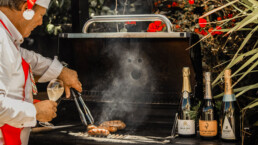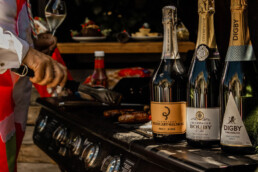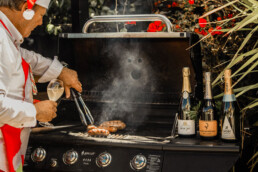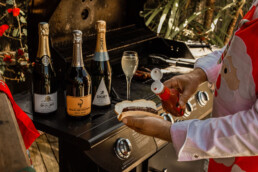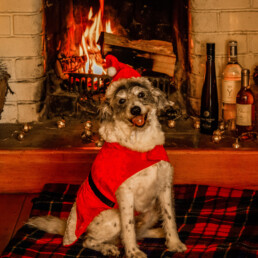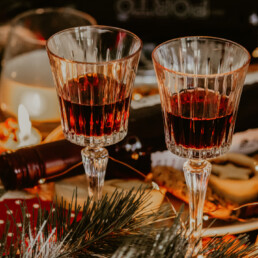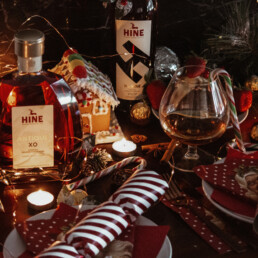What is Christmas and the holiday season all about? It’s all about celebrations! And what says celebrating more than anything else in the liquid form than BUBBLY!
Whether you are ringing in the New Year or gathering the family together for a holiday, sparkling wine is THE drink. It is made all over the world. But, not all bubbly is created equal – more specifically, all Champagne is sparkling wine, but not all sparkling wine is Champagne…
To help with your selection of festive fizz, be it for perfect pressies, party quaffers, an Xmas BBQ or just the joy of hearing that cork pop! we have put together a guide to Champagne and other popular types of sparkling wine. From Prosecco to Cava to Champagne and more.
Let the partaaay begin. ☺
How Sparkling Wine is Made
In order to get those frisky flirty bubbles in a bottle that we all know and love, sparkling wine has to be produced in a certain way. Every sparkling wine goes through two fermentation processes, but it is the second fermentation (the one that produces the bubbles) that differentiates them. There are numerous ways that sparkling wine can be produced, each method resulting in a different carbonation level. However, the two most popular sparkling wine production methods are the Traditional Method (Methode Traditionnelle) and the Tank Method (Charmat):
Traditional Method: What separates this method from the rest is that the second fermentation takes place in the bottle where sugars and yeasts are added. This method produces fine bubbles and is used when making Champagne and also in the case of some New World sparkling producers like our own De La Terre Cuvée II Methode Traditionnelle.
Tank (Charmat) Method: What makes this method different from the others is that the second fermentation process takes place in a large steel tank. This process creates larger bubbles that can be found in sparkling wines like Prosecco.
To help you navigate the wine aisle or restaurant wine list and choose the perfect wine for your taste buds, here’s a brief explanation…
Champagne – The Queen of Sparkling Wines
Sparkling wine can only be considered Champagne if it comes from the region of Champagne, in northeast France. The Champagne region retains its place as the world’s premier producer of sparkling wine – long associated with luxury and celebration. In the Champagne appellation they generally use three grape varieties: Chardonnay, Pinot Meunier and/or Pinot Noir. It is only made in the labour intensive classic traditional method of secondary fermentation taking place in the individual bottles. Most Champagne is typically made from blending these three grape varieties as they each offer different characters to enhance flavour profile and structure: Pinot Noir adds body, structure and complexity; Pinot Meunier adds fruit and floral aromas; and Chardonnay adds freshness, elegance and finesse.
How they blend these grapes and what portion they use of which grape changes the way the Champagne tastes and what style of Champagne it is. Blanc de Blancs is produced using only chardonnay grapes and is known to be a crisper, more citrus-driven style, while Blanc de Noir is produced using Pinot Noir or Pinot Meunier grapes and has greater body and more richness. These two styles respectively translate as “White from Whites” and “White from Blacks”, referring to the fact that neither style use skin contact in production and are therefore “white” in colour.
To make prestigious Champagne Rosé there are two methods to achieve the delightful pink hues: the first is rosé d’assemblage or blended Champagne with a small percentage (approx. 15%) of still red wine being added to the white wine assemblage. The second is Champagne rosé de saignée or when they ‘bleed’ dark skinned grapes to give colour to the white champagne assemblage.
What is the difference between Vintage & NV (Non-Vintage) Champagne?
Vintage Champagnes, such as the Billecart-Salmon Cuvée Nicolas-Francois Brut 2002, are made with grapes from a single year’s harvest and will have that year displayed on the bottle. Representing less than 5% of all production, they are typically produced in great vintages which sometimes only happen three or four times in a decade and reveal the highest expression of that Champagne house.
Vintage Champagnes must be aged for a minimum of three years in the bottle, as opposed to 15 months for non-vintage versions. Ageing is the luxury factor – there is a lot of painstaking work and cellaring and expensive real estate required to bring those gorgeous bottles of Champagne to us. Not only are they sourcing grapes from their best vintage, but the grapes are coming from highly venerated vineyards.
Non-Vintage Champagne (NV), is produced with grapes from multiple harvests. Often, it is an assembly of three to five vintages created to reflect a consistent house style by the Chef de Cave – the Champagne house’s Head Blender. While vintage Champagnes are celebrated for their uniqueness, non-vintages are valued for familiarity, often highlighting a label’s flagship tastes and aromas. Each Champagne maker has a house style. In some cases they are Pinot Noir-focused and are richer and bolder like André Clouet. Others, like Larmandier-Bernier, specialise in Chardonnay grapes, which make the Champagne more elegant and brighter and a little “nervier”. If you like a house’s specific style, you’ll probably like them across the spectrum – from non-vintage all the way through to vintage!
Have you heard about the on-trend cool ‘Grower Champagnes’? Check out the small print on the champagne labels:
‘RM’ (Récoltant Manipulant) means a grower that makes Champagne from his own grapes instead of selling to the larger ‘NM’ houses. There are more than 15,000 growers in Champagne and between them they own roughly 90% of the vineyards. About 2,000 of these growers choose to make their own Champagne. There will be many names you will never have heard of registered as ‘RM’ as they don’t have the huge marketing budgets of the large Champagne Maisons. In the Dhall & Nash portfolio we are honoured to have one of the finest Grower Champagnes with a cult following – Egly-Ouriet who have Grand Cru vineyard sites. Exceptional expression from exceptional terroir! It is this diversity of styles found among the grower producers (RM) that makes grower Champagne so fascinating – they offer a much wider array of expressions than were available in the region even just a couple of decades ago. These wines can often challenge orthodox ideas of what Champagne is, with their concentrated fruit flavours and intense, almost forceful personalities. This is part of the evolution of the appellation: an ongoing re-evaluation of the identity of Champagne in the modern day.
‘NM’ (Négociant Manipulant) appears beside the producer’s name, indicating the producer purchases a large proportion of the grapes, grape must or wine to make the Champagne. There are 380 houses who dominate sales and account for 2/3 of all Champagne shipments worldwide, but they only own about 10% of all the vineyards in France. You’ll know some names – Mumm, Moet, Veuve… Houses can be corporate-owned (for example Moet & Chandon and Veuve Clicquot are owned by LVMH), or family-owned and operated like Dhall & Nash’s Billecart-Salmon.
‘CM’ (Coopérative de Manipulation) is a cooperative that sells wines from its members’ grapes. Cooperatives are smaller in number and represent groups of growers who pool their resources – grapes, production facilities and marketing – to sell under a single label. Nicolas Feuillatte is the oldest and largest example of a co-op.
Sparkling Wine Dryness Levels (Grams per Litre)
When buying sparkling wine, you may notice that the bottle comes labelled with a word like “brut”, “dry” or something of that nature. These words are referring to the dryness level of the particular bottle you are buying. This is measured by the amount of residual sugar in grams per litre of wine. Because the terminology can be a bit confusing, we have explained the main levels of dryness for you below:
Extra Brut (0-6 g/l) is the driest form of sparkling wine with 0-6 grams per litre of residual sugar. This means that during the fermentation process the yeast has eaten most, if not all, of the sugar. Cava is a popular type of wine that can come in this form.
Brut (0-12 g/l) is the most popular form of sparkling wine because it is dry with just a hint of sweetness; it has less than 12 grams per litre of residual sugar. Champagne is a sparkling wine that often comes in the brut variety.
Extra Dry (12-17 g/l) While this bubbly drink is dry, it is not as dry as the two before it. It contains a slight sweetness left over from the fermentation process. When drinking this, do not expect a sugary sweet taste, but just hint of sweetness compared to the two above. Prosecco is a type of sparkling wine that is often extra dry.
Demi-Sec (32-50 g/l) is considered a sweet variety of wine that one would often drink with dessert. There is a noticeable amount of sweetness to the taste of this wine and it can have up to 50 grams per litre of residual sugar. Champagne can be made in this variety though it is not common. Demi-sec types of sparkling wine pair best with foods like chocolate, desserts or cheeses.
Doux (greater than 50 g/l) Finally, a wine whose classification means what it is, “sweet”. These delicious sparklers pack over 50 grams of residual sugar per litre. Liquid lusciousness!
And on the day… How long should you chill Champagne for?
In the rush of the big day, it’s easy to forget to put your fabulous bubbly on ice. But it’s worth getting right for any celebration and particularly on a scorcher of a Kiwi summertime Xmas day. The best way to chill Champagne is in a big bucket full of ice which takes about 10-15 minutes. For magnums, it’s about 25 minutes. If you need to hurry things along, use plenty of rock salt and a little water with the ice. The salt will melt the ice very quickly, the melted water being very cold and the Champagne will get chilled in less than 10 minutes. If you’ll be using your fridge to chill it, things will take longer – depending on the temperature of your fridge and how full it is – so plan ahead. Ideally Champagne tastes perfect chilled at 8-10 degrees Celsius.
So what are you waiting for? POP a bottle! Champagne is so incredibly versatile, it goes amazingly well with a wide variety of flavours and cuisines – in fact with just about anything from breakfast dishes to spicy foods to delicate fine foods and more. Champagne’s perky fine bubbles release racy freshness, with a tease of fruitiness, purity and precision vibrantly dancing across your palate. This is bottled poetry ready for all of life’s special moments.
The Other Sparkling Wines
Prosecco gets its name from the village it originated in – Prosecco, Italy. Prosecco is made from Glera grapes and tends to be on the sweeter side when it comes to taste. This particular sparking wine is made using the tank method (charmat), causing it to have larger bubbles and making it a popular addition to cocktails.
Cava is a sparkling wine that comes from Spain, in the region of Catalonia. It is produced in the traditional method and is primarily made from the Spanish grape, Macabeo, which adds a fresh, lemony flavour to the taste. It can also be made with Xarello and Parellada grapes which have fruity undertones of pear and citrus. All have floral aromas and are a lot less sweet in taste than Prosecco.
Crémant is a sparkling wine that can be produced in several areas of France such as Limoux, Loire and Burgundy. This particular sparkling wine is created in the same traditional method as Champagne and has a flavour that can vary depending on the type of grape it is made with. However, most types have a creamy and nutty taste rather than sweet.
